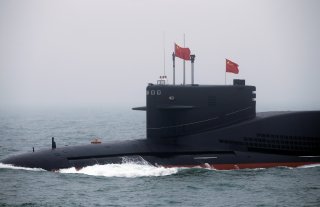China's 'Advanced' Type 095 Submarines: A U.S. Navy Nightmare?
How do America's subs compare?
Here's What You Need To Remember: The U.S. Office of Naval Intelligence may have said it best, “the PLA(N) will progress to the Type 095 SSN, which may provide a generational improvement in many areas such as quieting and weapon capacity.” Sailors beware.
Despite many years as a strictly littoral force, the People’s Liberation Army Navy has made steady advances in submarine design — and maybe leaving the United States behind. Here’s why.
Party Over Proficiency
For many years, China was the subject of ridicule in naval circles. The Korean War put the brakes on Chinese naval innovations (all innovations really), and the Cultural Revolution also hindered naval advancement in the name of the party.
Despite these setback, China has steadily developed its naval capabilities. Though Chinese naval advancement was initially focused on near-shore capabilities like smaller diesel submarines, shore-based missile defense, or fast littoral boats, China is now possibly capable of fielding a true blue-water submarine force.
Speaking last year at a Naval event, Captain Chester Parks, commanding officer of the Naval Submarine Base Kings Bay, said that foreign adversaries "are definitely catching up to us,” in the realm of submarine technology.
The Office of Naval Intelligence concurred, saying “the PLA(N) is currently transitioning from older, less reliable attack submarines like the Romeo SS, Ming SS and Han SSN to the more modern Kilo SS, Yuan SS, Shang SSN and the Type 095 SSN,” later calling the Type 095 “advanced.”
Marco
Submarines try to stay hidden when puttering around underwater. Put simply, there are two important variables at play when submarines play hide-and-seek: how loud a submarine is, and how good submarines are at detecting other submarines.
The naval expert H I Sutton detailed that ambient ocean noise is around 90 decibels, or roughly a motorcycle at 25 feet away. Submarines try to get to that noise level, or below there.
According to Sutton, western submarines made it to about the 90-decibel threshold twenty to thirty years ago. The U.S. Navy’s improved Los Angeles-class subs are near 110 decibels.
“Ten years ago the latest Chinese attack submarines were considered to be as quiet as the latest Russian Akula Class submarines” H I Sutton remarked. "Since these estimates were published in 2007, China has launched two improved variants of the Type-093 submarine. So it is a reasonable assumption that the latest Chinese boats will already be quieter.”
One commentator found it likely that the Type 095 would have electronic noise-cancellation technology, like your noise-canceling headphones, a shaftless drive, and a single hull. All of these would be a huge step forward for China’s submarine program.
The newer Type 095 submarines are just beginning to enter the water or will be able to in the near future. Would it be reasonable to assume the Type 095 would be even more advanced — that is quieter — than it’s predecessors? Absolutely.
Polo
The other factor, detection, is difficult to gauge.
Submarines use sonar to detect other subs. Sonar systems are typically trailed out behind submarines on lines. They can also be arrayed along the sides of the sub. Chinese submarines make use of both systems. How advanced are Chinese designs? Hard to say definitely — but almost certainly getting better and better.
Steady March into the Deep
While it is hard to estimate Chines submarine abilities with absolute certainty, submarine quietness trends are clear — they’re not getting any louder.
The U.S. Office of Naval Intelligence may have said it best, “the PLA(N) will progress to the Type 095 SSN, which may provide a generational improvement in many areas such as quieting and weapon capacity.” Sailors beware.
Caleb Larson is a Defense Writer with The National Interest. He holds a Master of Public Policy and covers U.S. and Russian security, European defense issues, and German politics and culture. This article first appeared earlier this year.
Image: Reuters.

